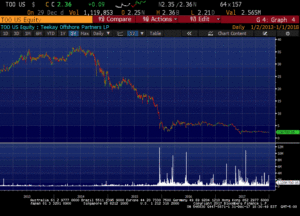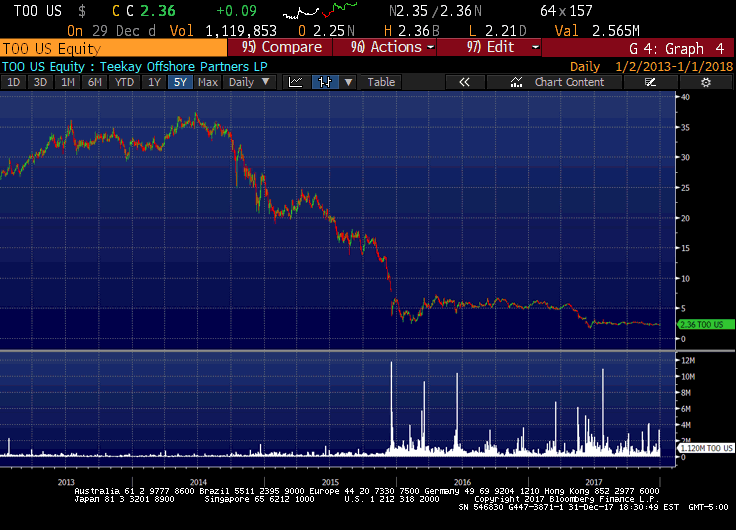Every once in a while a stock simply goes into the “too hard pile,” which creates opportunities.
Honestly, I don’t blame investors for sometimes giving up on the analytical side. I mean, Teekay Offshore Partners (TOO – USA) really is a klusterfuk for the ages. It was meant as a drop-down Ponzi vehicle (I wrote about those 2 years ago as the whole MLP Ponzi sector was imploding Part I, Part 2, Part 3), except it failed in its Ponzi implementation and the IDRs went too far out of the money for anyone upstairs at the parent to care about it anymore—except that the parent lent globs of money to the daughter, with guarantees and all that nonsense. Then, TOO went over-budget on projects—so far over-budget that the parent winced—at the same time that the whole offshore oil services sector imploded. With many hundreds of millions in vessels that were partly built and struggling to be financed, the parent panicked. In came Brookfield (BBU-U – Canada) with $610 million of cash to purchase new equity and bail out TOO.
If that had been the end of it, TOO would be at a higher price today. Unfortunately, BBU-U stepped into a mess. On one hand, you have floating production storage and offloading (FPSO) assets not getting renewed, while new-build FPSO assets are hopelessly over budget. On the other hand, this offshore oil services vehicle still has in-chartered conventional crude tankers that are losing money.
If TOO was meant to be easy to comprehend, management has done nothing to help the process. It would help if corporate disclosures on contract terms were complete, but transparency is only slightly better than a Soviet edition of Pravda. There isn’t even any forward guidance—then again given TOO’s recent track record, I wouldn’t have any faith in such guidance anyway. Is it any wonder that investors have given up? It’s just too hard. I’ve spoken with many smart people who follow this stock. Their estimates for normalized run-rate distributable cash flow (DCF) come in anywhere between 30 and 60 cents per share. You can tow an FPSO through that range of estimate—unfortunately, their towing sector is bleeding money as well.
Basically, this is a klusterfuk for the ages. When speaking of TOO, there are very few things that I’m confident in, excluding the fact that; there will be some huge impairment charges in the year-end financials and that everyone who’s ever bought shares of this company is underwater and hates management. In my mind, that also creates a lot of opportunity.

Yuck...
Look, I don’t know what will happen going forward—no one does. However, a whole slug of new assets that TOO has been spending money on will come online at some point between now and Q2/2018. These assets have contracts that were struck back when oil was at $100 and day-rates were quite high. This, in theory, should dramatically increase DCF. While the offshore oil services sector has yet to experience any uptick, with WTI back at $60, it’s unlikely to get incrementally worse and may begin to improve. Meanwhile, the shuttle tanker sector, which makes up about 40% of TOO’s business, is quite strong (more in future posts), which may lead to higher day rates going forward.
In summary, I understand why investors hate this stock—they cannot build a financial model for future cash flow. Investors cannot understand future contract risks. Investors are shell shocked, under water and hopelessly diluted. It would make almost anyone want to sell at year end and take his tax loss.
At the same time, Brookfield has a record for intelligence in their investments—if nothing else, they’re going to add some much needed adult supervision on the financial side. The assets themselves are good—particularly the shuttle tankers, and after Brookfield’s investment, the liquidity situation has finally stabilized. My financial model has a range that is embarrassingly imprecise, but I believe that normalized DCF will be at least 40 cents a share exiting 2018. It likely gets better in 2019 as high interest rate debt is paid off or refinanced at more normal rates under Brookfield's imprimatur. In the end, Brookfield paid about $2 per share (including their warrants). TOO is now trading 15% higher than what Brookfield paid in a recap at the bottom of the cycle and it’s been six months since the deal was announced. Additionally, their warrants only vest if the shares trade for over $4.00 a share. I suspect that since they were the only ones willing to bail out TOO, they only agreed to these terms because they believed that $4.00 a share was pretty certain. Why wouldn’t it be, as that’s only ten times the low-end of my DCF range. In fact, after a few years of debt pay-down, I wouldn’t be surprised if DCF was a good deal higher. In any case, I believe that I’m paying something between 4 and 6 times normalized 2019 DCF, with DCF set to increase as debt is paid down. This works out to between 2 and 4 times current cash flow (DCF being something of an abstract metric and all). Despite long-dated contracts on most assets, I cannot give you tighter ranges for any financial metric—which is a function of multiple moving pieces and abysmal disclosure. This uncertainty creates the opportunity.
I suspect that going forward; everything will normalize to the “Brookfield Standard” where all disclosure is targeted at the least sophisticated Canadian pensioner seeking out a stabilized 5% dividend yield. Meanwhile, I'm coming into this at something between a 25 and 50% cash flow yield. After some debt pay-down, Brookfield will ensure that their Canadian clientele are endowed with their yields—but first, Brookfield will get a good chunk of equity appreciation on the 64% of the fully diluted shares that they own. Fortunately, I'll get to go along for the ride as a minority owner.
After the fourth quarter impairments, I think that 2018 starts looking VERY normalized, with optimistic forward guidance and lots of new disclosure, at which point institutional investors will come back in. Let’s just say, that during tax loss season, I’ve made this into a decent sized position. I know it has issues. As they get sorted, I expect appreciation. Caveat Emptor.
Disclosure: Funds I manage are long TOO






